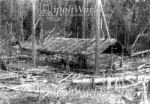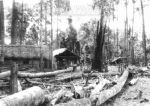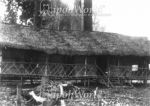We've tried to ensure the information displayed here is as accurate as possible. Should there be any inaccuracies, we would be grateful if you could let us know at info@ipohworld.org . All images and content are copyright.
(Please click on the thumbnail for a bigger image.)
Fort Kemar - The Building Of A Malayan Jungle Fort - Part 6
Thumbnail :



Subject :Fort Kemar - The Building Of A Malayan Jungle Fort - Part 6
Published By : None
Location : Perak
Estimated Year : 1953
Media Type : Photograph
Source : Dennis Wombell, UK
Remark : By the end of the first week we had cleared enough jungle at the fort area to enable us to move there and to set up a more permanent and more comfortable camp and we received our first airdrop at the fort itself on the 5th. March. By the 10th we had cleared and levelled the helicopter landing pad and were ready to receive visitors. Life became a great deal easier; it was no longer necessary to split up my platoon in order to leave a section at the camp, nor did we have to endure the daily trudge to and from the fort and we established a comfortable working routine.
As on all prolonged jungle operations we received an airdrop every 4 days and these initial drops were substantial. In addition to our normal requirements of food and supplies for my platoon, we needed a constant supply of construction tools and equipment for the building of the fort. We also needed a significant amount of rice, dried fish, salt and tobacco, used as currency to pay our large Orang Asli workforce, to whom, at that stage, cash was of little use. It was an endless list, all to be dropped by parachute from Valetta aircraft. Although, for most of the time, we lived on tinned operational rations, known as `compo` rations, we also received a supplement of fresh meat and vegetables with every drop. These were very popular given the conditions in which we lived. I was also able to order personal items for myself and my men through the civilian Rations Supply Contractor in Kuala Lumpur, who, it appeared, was able to procure almost anything, and I tested him to the full. He obviously saw this as a challenge, and far from showing irritation or impatience, he supplied me with, amongst other things, Dunhill`s curved briar pipes, their `My Mixture` pipe tobacco, and various obscure Turkish cigarettes! The men also were able to order their cigarettes and tobacco and other supplements to enhance their basic rations. An account was kept of all these personal purchases which had to be paid for by the individual at the end of the operation.
There was great excitement and anticipation on airdrop days. The drops usually took place at about 11.00 am, and, after breakfast, a bonfire was prepared at the edge of the DZ, ready to provide smoke to enable the pilot to locate his target from a distance, since, in deep jungle, a clearing can be seen only from directly overhead. The smoke also indicates the speed and direction of the wind. Large translucent yellow cloth recognition panels were also pegged out in the centre of the clearing - in my case in the form of an `F` - to enable the pilot and his despatch crew to identify us. No one, who has lived for any length of time in isolation and cut off from the outside world, will ever forget the drone of an approaching aircraft, or the clopper-clopper of a helicopter, bringing news, food, cigarettes, and, above all, the mail, with letters from friends and family. Initially, the pilot would fly over in a `dry run`, and then, having checked the recognition panel and the wind, would turn in a wide circle and return to commence his drop, one load at a time and circling until the drop was completed. He would then fly over once more, dipping his wings and, with a salute from the despatcher standing at the open door, disappear over the jungle covered hills.
On the ground, the excitement would then begin, as the men, helped by hoardes of screaming, laughing, Orang Asli children would run down to the DZ, cut the straps binding the boxes which made up the loads and carry them back to a central point in the camp where Sergeant Yusoff and I would supervise the distribution, finishing with the men`s personal items - their longed-for mail, their even more-longed-for cigarettes and the various spices which helped enhance their `compo` rations and fresh food allowance. The evening after an airdrop was one of great contentment, when, after the day`s work was finished, the fresh food was cooked, the mail read and the men whose cigarettes had been exhausted, were able to relax in their smoke-filled bashas.
The photographs show the first buildings of the Fort, taking shape to a level where the team could live in it.
To go to Part 7, click here.
As on all prolonged jungle operations we received an airdrop every 4 days and these initial drops were substantial. In addition to our normal requirements of food and supplies for my platoon, we needed a constant supply of construction tools and equipment for the building of the fort. We also needed a significant amount of rice, dried fish, salt and tobacco, used as currency to pay our large Orang Asli workforce, to whom, at that stage, cash was of little use. It was an endless list, all to be dropped by parachute from Valetta aircraft. Although, for most of the time, we lived on tinned operational rations, known as `compo` rations, we also received a supplement of fresh meat and vegetables with every drop. These were very popular given the conditions in which we lived. I was also able to order personal items for myself and my men through the civilian Rations Supply Contractor in Kuala Lumpur, who, it appeared, was able to procure almost anything, and I tested him to the full. He obviously saw this as a challenge, and far from showing irritation or impatience, he supplied me with, amongst other things, Dunhill`s curved briar pipes, their `My Mixture` pipe tobacco, and various obscure Turkish cigarettes! The men also were able to order their cigarettes and tobacco and other supplements to enhance their basic rations. An account was kept of all these personal purchases which had to be paid for by the individual at the end of the operation.
There was great excitement and anticipation on airdrop days. The drops usually took place at about 11.00 am, and, after breakfast, a bonfire was prepared at the edge of the DZ, ready to provide smoke to enable the pilot to locate his target from a distance, since, in deep jungle, a clearing can be seen only from directly overhead. The smoke also indicates the speed and direction of the wind. Large translucent yellow cloth recognition panels were also pegged out in the centre of the clearing - in my case in the form of an `F` - to enable the pilot and his despatch crew to identify us. No one, who has lived for any length of time in isolation and cut off from the outside world, will ever forget the drone of an approaching aircraft, or the clopper-clopper of a helicopter, bringing news, food, cigarettes, and, above all, the mail, with letters from friends and family. Initially, the pilot would fly over in a `dry run`, and then, having checked the recognition panel and the wind, would turn in a wide circle and return to commence his drop, one load at a time and circling until the drop was completed. He would then fly over once more, dipping his wings and, with a salute from the despatcher standing at the open door, disappear over the jungle covered hills.
On the ground, the excitement would then begin, as the men, helped by hoardes of screaming, laughing, Orang Asli children would run down to the DZ, cut the straps binding the boxes which made up the loads and carry them back to a central point in the camp where Sergeant Yusoff and I would supervise the distribution, finishing with the men`s personal items - their longed-for mail, their even more-longed-for cigarettes and the various spices which helped enhance their `compo` rations and fresh food allowance. The evening after an airdrop was one of great contentment, when, after the day`s work was finished, the fresh food was cooked, the mail read and the men whose cigarettes had been exhausted, were able to relax in their smoke-filled bashas.
The photographs show the first buildings of the Fort, taking shape to a level where the team could live in it.
To go to Part 7, click here.
Filename : 20111204-023